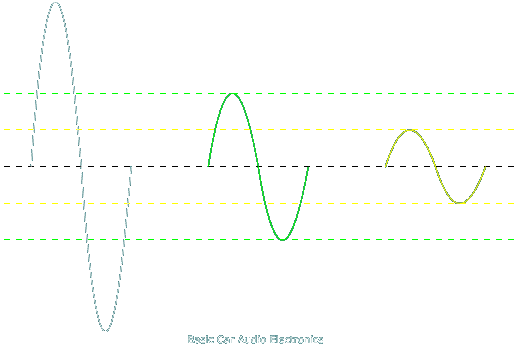Preamp Output Voltage
You have probably heard (or read about) people discussing 2 or 4 volt output head units. This section will help you (hopefully) to understand what they're talking about. If you haven't read the 'audio output' or 'head unit' pages, you should go read them now. The 'op-amp' page will also be of interest to those who want to know more about the electronic components.
Regulators:
In virtually all head units, the available voltage is the battery or charging system voltage. The voltage supplied by the charging system is not exactly 'clean'. It has all sorts of spikes and dips from electrical accessories turning on or off (or just from the current they pull). Most head units use op-amps (covered earlier) as buffers on their preamp audio outputs. These op-amps can reject some of the noise from the power supply but not all noise. To get a 'cleaner' power supply, the engineers employ a voltage regulator. This voltage regulator reduces the voltage to approximately 10 volts. The op-amps operate from this regulated voltage. The following diagram shows the 'dirty' voltage from the charging system and the 'clean' regulated voltage. OK, enough about regulators.

Op-amps:
In general, most op-amps cannot drive their outputs all the way to ground or to the regulated voltage. They may not be able to drive their output within 1.7 volts of either. This means that their output signal is limited to the regulated voltage (9 volts) minus 3.4 volts (1.7 * 2) equals 5.6 volts. Now remember that we are talking about peak-peak voltage output. The RMS voltage is only 35% of the peak to peak values. This means that the output from the op-amp will be limited to 1.96 (2) volts.
Rail to Rail Op-amps:
In recent years, the audio manufacturers started using op-amps that could swing very close to the full supply voltage. This means that their peak-peak output voltage is very close to 9 volts.
This means that their RMS output voltage can be as high as 35% of the regulated voltage. With a regulated voltage of 9 volts, they can get 3.15 volts out. If they increase the regulated voltage to 10.5 volts, they can get close to the claimed 4 volts out without a switching power supply. Some head units will use a second, inverted 4 volt output on the pre-amp output shield (which would otherwise be connected to ground). This will produce a balanced 8 volt output. This configuration is similar to amplifier bridging.
Switching Power Supplies:
A few head units and more than a few signal processors, use a switching power supplies (similar to those used in amplifiers) to get a 30 volt (plus or minus 15 volts) power source. These are getting even more popular in decks that have EL (electro-luminescent) displays. In these devices, the op-amp can swing to within 1.7 volts of the +&-15 volts for a total peak-peak voltage of ~26.6 volts. The RMS output can be as high as 9 volts. You will see this type of output rating on many equalizers and crossovers.
The diagram below shows the relationship between the voltage output levels of each of the types of outputs. The white line would represent the voltage output produced by the op-amp powered by the switching power supply. The green colored waveform, the 4 volt output. The yellow, the 2 volt output.

NOTE:
A piece of equipment that has a higher maximum output voltage is not necessarily going to sound better than one which is only capable of 2 volts output. The higher output will allow you to reduce the gains on your amp (or any down line signal processor) which will lower the noise floor of your system. If you are not having trouble with noise (alternator, hiss...), you may not benefit from the extra output voltage. You also need to realize that the voltage may be more than your amplifiers can handle. The extra voltage will not damage the amplifier but if the lowest sensitivity (gain setting) on your amp is 2 volts, and you drive it with anything more than 2 volts, it will cause your amp to clip*.
*This assumes that the gain setting is the voltage that will drive the amp to max power. Some amps are underrated and may have slightly more headroom and therefore will clip at a little higher power.
Output Impedance:
Some head units (or other devices that have an audio output signal) rate the output impedance of their pre-amp lines. These specs will tell you how robust the output signal is. Since all decks have more than a zero output impedance (50-500 ohms) and all other devices have something less than an infinite input impedance (10,000-100,000 ohms), the input circuit will affect the signal from the previous piece of audio equipment. A lower output impedance (50 ohms) will be affected less than one with a higher output impedance (500 ohms). The most common (and least degrading) effect on the signal is the slight reduction in the signal level. This slight reduction is generally never noticed and is completely normal. A bigger problem appears when some piece of equipment does not have a purely resistive input circuit. This is generally from a ultrasonic filter on the input. These will cause the high frequency part of the signal to be attenuated more than the rest of the signal. Equipment with higher output impedances will have more high frequency roll off than those with a lower output impedance.
|






